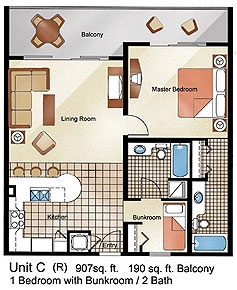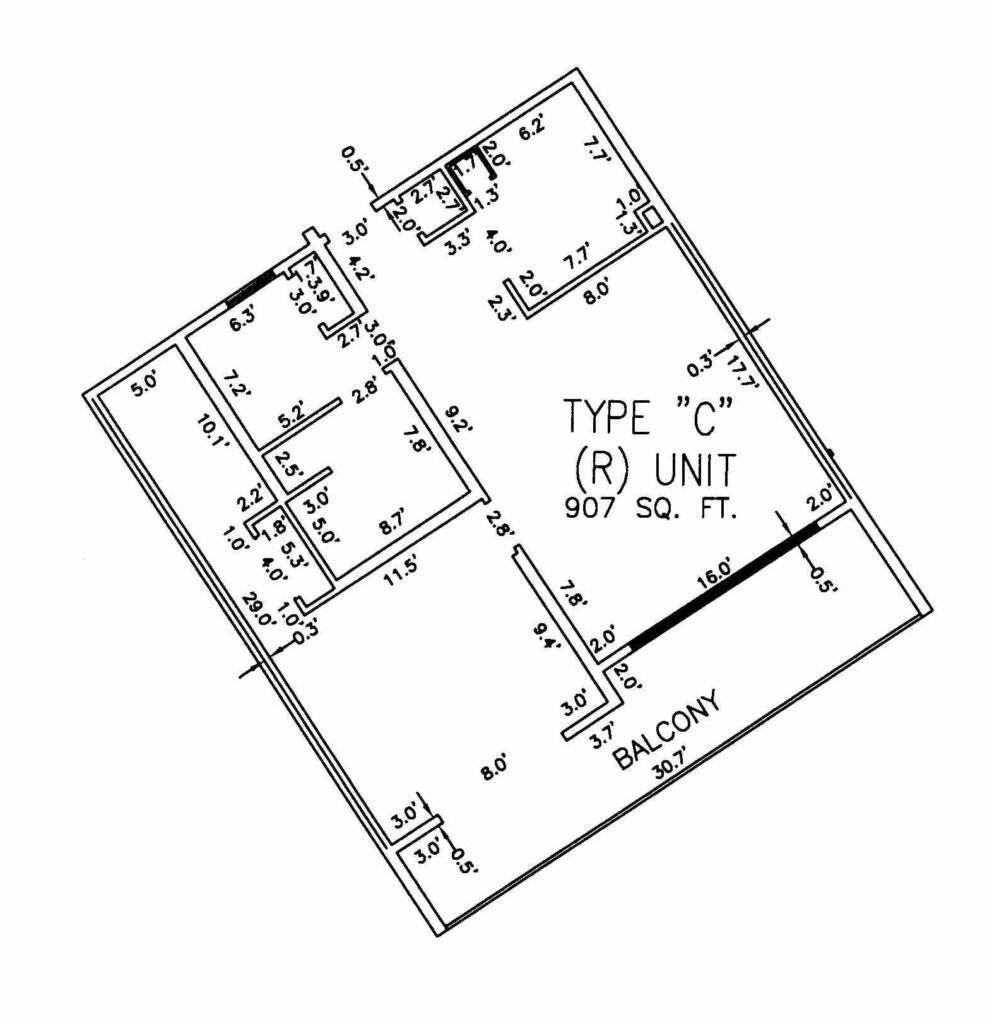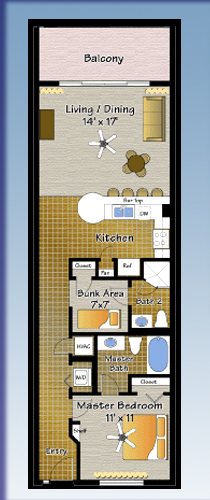When browsing condominium listings in Florida, you may encounter units with identical floor plans described inconsistently as a “one bedroom plus bunk room” or a “two bedroom.” This discrepancy can confuse buyers, and renters. To clarify whether a condominium with a bunk room should be classified as a one-bedroom or two-bedroom unit, we’ll examine two examples with identical layouts: a 907-square-foot unit at Shores of Panama and an 862-square-foot unit at Majestic Condominium, both in Florida. We’ll also reference the Florida Building Code (FBC) to provide clarity on bedroom requirements for condominiums.
Case Study 1: Shores of Panama 907-Square-Foot Unit

The Shores of Panama offers a 907-square-foot condominium with a layout that includes a primary bedroom and a bunk room measuring just under 8 feet by 8 feet, totaling 64 square feet. Despite the identical floor plan, some agents market it as a “one bedroom plus bunk room” while others list it as a “two bedroom.”

Why It’s Called a One Bedroom Plus Bunk Room:
- Size: At 64 square feet, the bunk room does not meet the FBC’s minimum requirement of 80 square feet for a single-occupancy bedroom.
- Functionality: The bunk room is designed for bunk beds, typically for children, rather than as a full bedroom.
- Privacy and Features: The bunk room originally conveyed without a door, though some owners have since added one.
Why It’s Called a Two Bedroom:
- Market Appeal: Labeling the unit as a two-bedroom can enhance its perceived value in competitive markets like Panama City Beach.
Per the Florida Building Code, the Shores of Panama unit is more accurately described as a one bedroom plus bunk room because the 64-square-foot bunk room falls short of the FBC’s 80-square-foot minimum and likely lacks a closet or egress window. However, marketing it as a two-bedroom is common by real estate agents.
Case Study 2: Majestic Condominium 862-Square-Foot Unit

The Majestic Condominium’s 862-square-foot unit has an similar floor plan to the Shores of Panama unit, featuring a primary bedroom and a bunk room measuring 7 feet by 7 feet (49 square feet). Despite the similar layout, it’s listed inconsistently as either a one-bedroom or two-bedroom condo.
Why It’s Called a One Bedroom Plus Bunk Room:
- Size: The 49-square-foot bunk room is well below the FBC’s 80-square-foot minimum for a bedroom, making it non-compliant as a bedroom under Florida law.
- Limited Features: The bunk room is likely designed for compact sleeping arrangements and lacks a closet and window, all required by the FBC.
Why It’s Called a Two Bedroom:
- Appeal to Buyers/Renters: The bunk room adds sleeping capacity, a major selling point for vacation properties. Calling it a two-bedroom emphasizes this benefit.
According to the Florida Building Code, the Majestic Condominium unit is best described as a one bedroom plus bunk room due to the bunk room’s 49-square-foot size, which is significantly below the 80-square-foot requirement, and its lack of a closet or egress window. Marketing it as a two-bedroom is common in the Panama City Beach market but does not align with FBC standards.
Understanding the Debate: One Bedroom vs. Two Bedroom
The inconsistent labeling of condominiums as one-bedroom or two-bedroom units often stems from the bunk room’s characteristics. Some real estate agents market units with bunk rooms as two-bedroom condos for sale in Panama City Beach to highlight their sleeping capacity. Others adhere to the stricter one-bedroom designation to align with FBC standards. For the Shores of Panama and Majestic Condominium units, the floor plans are identical. Some agents call them one bedroom plus bunk room, and others list them as two bedrooms.
Florida Building Code: Bedroom Requirements for Condominiums
In Florida, the classification of a room as a “bedroom” in a condominium is governed by the Florida Building Code (FBC), specifically the 2023 Florida Building Code, Residential, Eighth Edition, and related statutes. According to Chapter 381, Section 0065 of the 2024 Florida Statutes and the FBC, a bedroom in a site-built dwelling, such as a condominium, must meet the following criteria:
- Minimum Size: A single-occupancy bedroom must provide at least 80 square feet of usable floor space. For multiple-occupancy bedrooms, a minimum of 60 square feet per bed is required, with a limit of four occupants.
- Egress: The room must have an emergency means of escape and rescue opening to the outside, such as a window or door, in accordance with the FBC.
- Door: The room must have a door or an entrance where a door could reasonably be installed for privacy.
- Closet: The FBC specifies that a bedroom must have a closet or space for a wardrobe.
- Exclusions: A room cannot be considered a bedroom if it is used to access another room (except a bathroom or closet) or if it is a hallway, bathroom, kitchen, living room, family room, dining room, den, breakfast nook, pantry, laundry room, sunroom, recreation room, media/video room, or exercise room.
These requirements apply to condominiums as they are considered site-built dwellings under the FBC. The code ensures safety, habitability, and consistency in property classifications, particularly for appraisals, financing, and septic system sizing in Florida.

In California’s MLS services, it is simply forbidden to list a bedroom if it does not qualify as one.